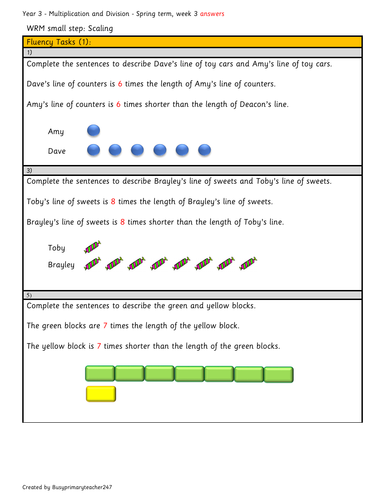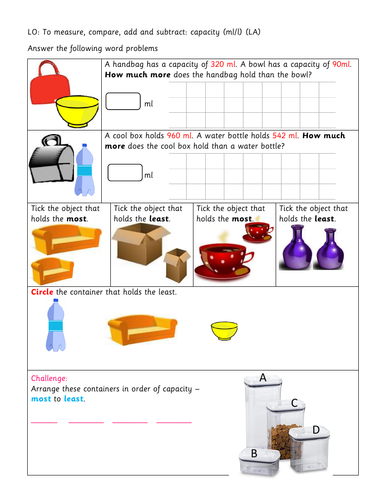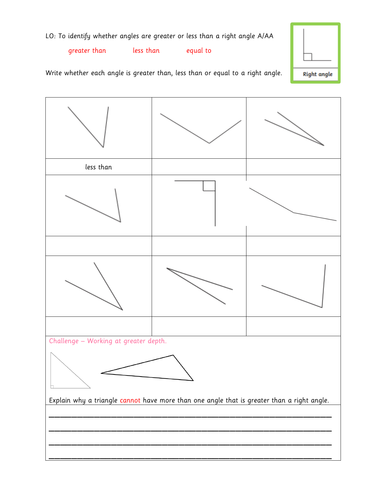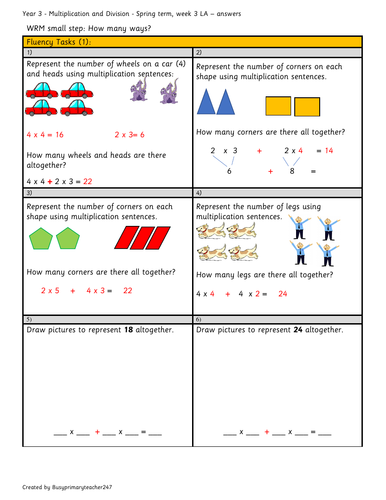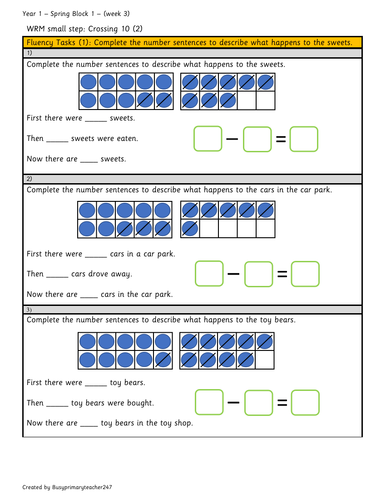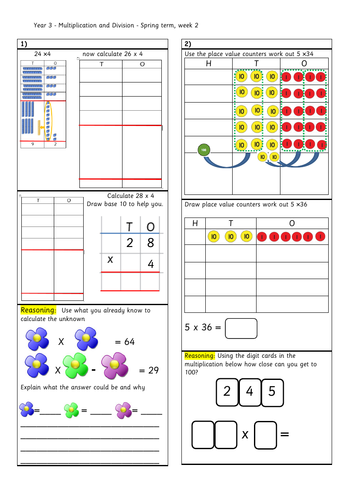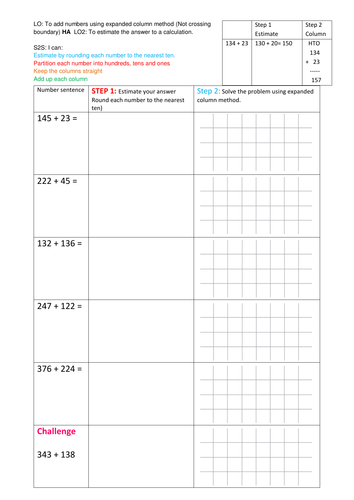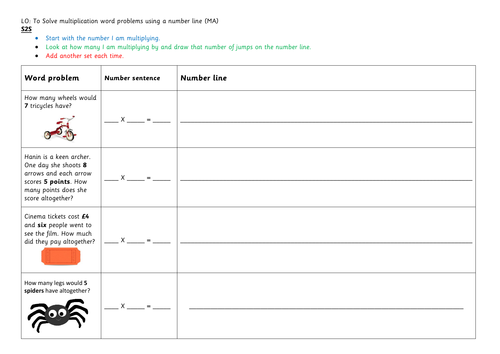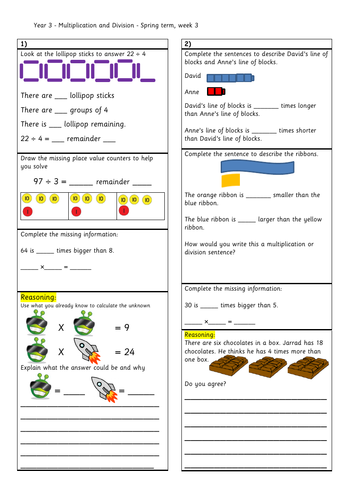132Uploads
175k+Views
66k+Downloads
All resources

Year 3 - Identifying horizontal, vertical, parallel and perpendicular lines
Worksheet / assessment focusing on identifying horizontal, vertical, parallel and perpendicular lines. Differentiated BA and A AA (Includes Greater depth question)
Links with Year 3 National Curriculum and Rising Stars objectives.

Year 3 - Spring block 1 - Scaling (week 3)
This set of resources follows the concrete-pictorial-abstract method of WRM and Maths Mastery. It contains fluency, reasoning, and problem-solving tasks linked to WRM small step - Scaling (week 3)
The worksheets are differentiated between lower ability and age-related and the answers are included :)
UK National curriculum links:
-Recall and use multiplication and division facts for the 3, 4 and 8 multiplication tables.
-Write and calculate mathematical statements for multiplication and division using the multiplication tables they know, including for two-digit numbers times one-digit numbers, using mental and progressing to formal written methods.
-Solve problems, including missing number problems, involving multiplication and division, including positive integer scaling problems and correspondence problems in which n objects are connected to m objectives.
Australian Curriculum (V8.3)
-Apply place value to partition, rearrange and regroup numbers to at least 10 000 to assist calculations and solve problems (ACMNA053)
-Recall multiplication facts of two, three, five and ten and related division facts (ACMNA056)
-Represent and solve problems involving multiplication using efficient mental and written strategies and appropriate digital technologies (ACMNA057)
-fluency includes recalling multiplication facts, using familiar metric units to order and compare objects, identifying and describing outcomes of chance experiments, interpreting maps and communicating positions.
-problem-solving includes formulating and modelling authentic situations involving planning methods of data collection and representation, making models of three-dimensional objects and using number properties to continue number patterns
- reasoning includes using generalising from number properties and results of calculations, comparing angles and creating and interpreting variations in the results of data collections and data displays.
I hope you find these resources helpful!
Your feedback is always welcome x

Year 3 - differentiated worksheets - Capacity
Here are 2 differentiated worksheets based on the capacity of objects. It includes addition, subtraction, multiplication (integer scaling) and reasoning questions.
Curriculum links:
-Measure, compare, add and subtract: Capacity (ml/l)
-Compare the capacity of objects using mixed units (ml/l)
-Compare the capacity of objects using simple scaling by integers.
I hope you find this resource useful.
Your feedback is always welcome x

Year 3 - Greater than less than a right angle differentiated assessment
Worksheet / assessment focusing on angles being greater than or less than a right angle. Differentiated into BA and A/AA (Includes greater depth question)
Links to Rising Stars Objectives: Identify angles greater than or less than a right angle.

Question strips to go with year 3, Spring block 1 - Multiplication and division (1)
Question strips to complement varied fluency and reasoning for Year 3 Spring block 1 - Multiplication and Division.
Small step -Comparing statements
Curriculum links:
- Recall and use multiplication and division facts for the 3, 4 and 8 multiplication tables.
-Write and calculate mathematical statements for multiplication and division using the multiplication tables they know, including for two-digit
numbers times one-digit numbers, using mental and progressing to formal written methods.
I hope this resource is helpful!
Your feedback is always welcome x

Year 3 - Spring Block 1 (week 3) Small step - How Many Ways?
This set of resources follows the concrete-pictorial-abstract method of WRM and Maths Mastery. It contains fluency, reasoning, and problem-solving tasks linked to WRM small step - How many ways? (week 3)
The worksheets are differentiated between lower ability and age-related and the answers are included :)
UK National curriculum links:
-Recall and use multiplication and division facts for the 3, 4 and 8 multiplication tables.
-Write and calculate mathematical statements for multiplication and division using the multiplication tables they know, including for two-digit numbers times one-digit numbers, using mental and progressing to formal written methods.
-Solve problems, including missing number problems, involving multiplication and division, including positive integer scaling problems and correspondence problems in which n objects are connected to m objectives.
Australian Curriculum (V8.3)
-Apply place value to partition, rearrange and regroup numbers to at least 10 000 to assist calculations and solve problems (ACMNA053)
-Recall multiplication facts of two, three, five and ten and related division facts (ACMNA056)
-Represent and solve problems involving multiplication using efficient mental and written strategies and appropriate digital technologies (ACMNA057)
-fluency includes recalling multiplication facts, using familiar metric units to order and compare objects, identifying and describing outcomes of chance experiments, interpreting maps and communicating positions.
-problem-solving includes formulating and modelling authentic situations involving planning methods of data collection and representation, making models of three-dimensional objects and using number properties to continue number patterns
- reasoning includes using generalising from number properties and results of calculations, comparing angles and creating and interpreting variations in the results of data collections and data displays.
I hope you find these resources helpful!
Your feedback is always welcome x

Year 2 - WRM Spring block 2 - Statistics - Making Tally Charts (week 3)
This resource covers the first small step for Spring block 2 - Statistics - Making Tally Charts.
It is differentiated 2 ways and includes answers.
Enjoy x

Year 1 - Spring Block 1 - Week 3 - Small Step: Subtraction crossing 10 (2)
This resource covers Year 1 - Addition and Subtraction (within 20) - block 1 - Spring (week 3).
It follows the CPA approach to mastery and links to the 6th WRM small step: 'Subtraction crossing 10 (2)'
I will be publishing week 4 asap.
National Curriculum links:
- Represent and use number bonds and related subtraction facts within
20
- Read, write and interpret mathematical statements involving addition (+), subtraction (-) and equals (=) signs.
- Add and subtract one-digit and two-digit numbers to 20, including zero.
- Solve one-step problems that involve addition and subtraction, using concrete objects and pictorial representations, and missing number problems such as 7= ꙱ –9
Enjoy!
Your feedback is always welcome x

Year 3 differentiated worksheet on comparing unit fractions
Year 3 differentiated worksheets on comparing unit fractions. AA includes greater depth reasoning question.
Links to Rising Star's objective: Compares simple unit fractions.

Year 3 question strips - Multiplication and Division - Spring block 1 (2)
Question strips to complement varied fluency and reasoning for Year 3 Spring block 1 - Multiplication and Division.
Small step -Related calculations
Curriculum links:
- Recall and use multiplication and division facts for the 3, 4 and 8 multiplication tables.
-Write and calculate mathematical statements for multiplication and division using the multiplication tables they know, including for two-digit
numbers times one-digit numbers, using mental and progressing to formal written methods.
I hope this resource is helpful!
Your feedback is always welcome x

Year 3 - question strips linked to - Multiplication and Division (CPA) block 3 - Autumn week 10
This resource contains 5, question strips that follow the maths mastery approach (CPA - Concrete, pictorial, abstract). They match week 10 of Multiplication and Division for Autumn term.
Links to year 3 National Curriculum
- Recall and use multiplication and division facts for the 3, 4 and 8 multiplication tables.
- Write and calculate mathematical statements for multiplication and division using the multiplication tables they know, including for two-digit numbers times one-digit numbers, using mental and progressing to formal written methods.
- Solve problems, including missing number problems, involving multiplication and division, including positive integer scaling problems and correspondence problems in which 'n' objects are connected to 'm' objectives.
Enjoy!
Your feedback is always welcome x

Year 3 - Question strips based on block 1, Multiplication and Division, Spring Term , week 1
This resource has been created to match block 1, week 1 of the spring term - Multiplication (for year 3). They follow the concrete-pictorial-abstract method of Maths Mastery and also include problem-solving and reasoning questions.
Links to WRM small steps:
-Comparing statements
-Related calculations
-Multiply 2-digits by 1-digit (1)
Links to the National Curriculum:
- Recall and use multiplication and division facts for the 3, 4 and 8 multiplication tables.
- Write and calculate mathematical statements for multiplication and division using the multiplication tables they know, including for two-digit numbers times one-digit numbers, using mental and progressing to formal written methods.
- Solve problems, including missing number problems, involving multiplication and division, including positive integer scaling problems and correspondence problems in which n objects are connected to m objectives.
Enjoy! Your feedback is always welcome.
Pictures used in this resource have been created by Busyprimaryteacher247
Other images sourced from - https://wpclipart.com

Fractions word wall vocabulary cards
This resource contains 33 fraction based vocabulary cards to be used as flash cards or as part of a display on a working wall. It is appropriate for years 2 - 6.
I hope you enjoy this product!
Your feedback is always welcome x

Year 2 - WRM Spring Block 2 - Statistics - week 3 - Making Pictograms (1:1)
This resource covers Small step 2 of the WRM Spring block 2 (Statistics) Making Pictograms (1:1)
The worksheets are differentiated 2 ways and include answers.
I've also added the reasoning questions for this step and an extension task that allows children to make their own.
Curriculum Links:
-Interpret and construct simple pictograms, tally charts, block diagrams and simple tables.
I hope you find this useful!
Your feedback is always welcome x

Year 3 - 3-digit by 2-digit column addition with estimating and rounding (No exchanging)
Year 3
3-digit by 2-digit column addition with estimating and rounding (No exchanging) Differentiated worksheets BA, MA, HA
Enjoy! Your feedback is always welcome x

Year 3 - Using a number line to solve multiplication word problems - Differentiated
Year 3 - Using a number line to solve multiplication word problems - Differentiated BA, MA, HA
Enjoy! Your feedback is always welcome x

5 question strips linked to Year 3 Multiplication and division, Autumn week 11
This resource contains 5 question strips that link to Multiplication and Division Autumn week 11. They follow the mastery approach (concrete, pictorial, abstract) to help pupils develop a deep understanding. Problem-solving and reasoning questions are also included.
National Curriculum links:
- Recall and use multiplication and division facts for the 3, 4 and 8 multiplication tables.
- Write and calculate mathematical statements for multiplication and division using the multiplication tables they know, including for two-digit numbers times one-digit numbers, using mental and progressing to formal written methods.
- Solve problems, including missing number problems, involving multiplication and division, including positive integer scaling problems and correspondence problems in which 'n' objects are connected to 'm' objectives.
Enjoy! Your feedback is always welcome x

Question strips for year 3 - multiplication and division - Spring bock 1 (3)
Question strips to complement varied fluency and reasoning for Year 3 Spring block 1 - Multiplication and Division.
Small step -Multiply 2-digits by 1-digit (1)
Curriculum links:
- Recall and use multiplication and division facts for the 3, 4 and 8 multiplication tables.
-Write and calculate mathematical statements for multiplication and division using the multiplication tables they know, including for two-digit
numbers times one-digit numbers, using mental and progressing to formal written methods.
-Solve problems, including missing number problems, involving multiplication and division, including positive integer scaling problems
and correspondence problems in which n objects are connected to m
objectives.
I hope this resource is helpful!
Your feedback is always welcome x

5 SPaG question strips for years 3 and 4 (set 1)
This resource contains 5 question strips linked to the year 3 and 4 SPaG curriculum.
Curriculum links:
- Write from memory simple sentences dictated by the teacher, that include words and punctuation taught so far.
- Spell further homophones.
- Spell words that are often misspelt (year 3 /4 common exception words).
- Use further prefixes and understand how to add them
- Use further suffixes and understand how to add them
- Use the correct form of ‘a’ or ‘an’
- Use inverted commas to punctuate direct speech
- Place the possessive apostrophe accurately in words with regular plurals e.g. girls’, boys’ and in words with irregular plurals e.g. children’s.
I hope you find this useful.
Your feedback is always welcome x
Images sourced from https://wpclipart.com/index.html

Year 1 - Place Value - Counting objects
This resource follows the mastery approach to Year 1 place value (concrete - pictorial - abstract) with a main focus on counting objects.
Resources included in this pack:
Power point presentations
Working wall display items
Student worksheets differentiated lower ability, age related, greater depth (plus answers)
Reasoning and problem solving
Curriculum Links:
UK:
Count, read and write numbers to 10 in numerals and words.
Given a number, identify one more or one less.
Identify and represent numbers using objects and pictorial representations including the number line, and use the language of: equal to, more than, less than (fewer), most, least.
Australia:
ACMNA013 - modelling numbers with a range of material and images
ACMNA002 - Connect number names, numerals and quantities, including zero, initially up to 10 and then beyond
ACMNA289 - Compare, order and make correspondences between collections, initially to 20, and explain reasoning
American Common Core Standards
CCSS.MATH.CONTENT.K.CC.A.3
Write numbers from 0 to 20. Represent a number of objects with a written numeral 0-20 (with 0 representing a count of no objects).
CCSS.MATH.CONTENT.K.CC.B.4.A
When counting objects, say the number names in the standard order, pairing each object with one and only one number name and each number name with one and only one object.
CCSS.MATH.CONTENT.K.CC.B.4.C
Understand that each successive number name refers to a quantity that is one larger.


